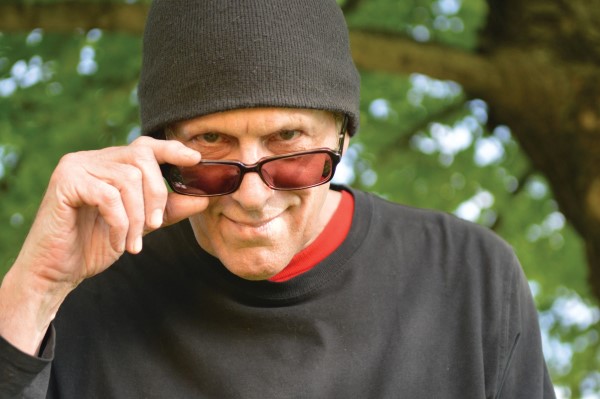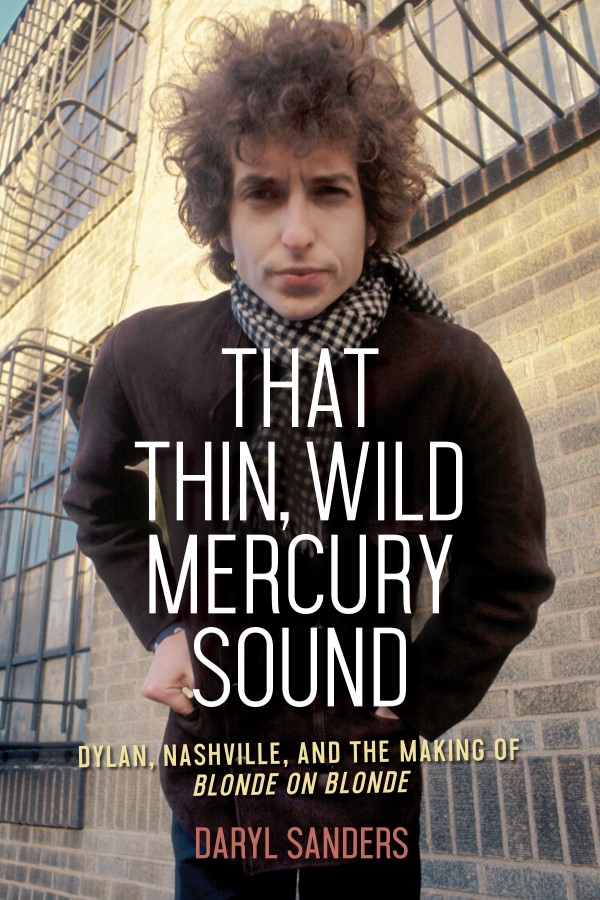
Daryl Sanders, author of That Thin, Wild Mercury Sound: Dylan, Nashville, and the Making of Blonde on Blonde
While Bob Dylan breathes rarefied air shared with none but the most iconic of musical acts—The Beatles, U2 and Bruce Springsteen chief among them—only Dylan has inspired an entire field of study: Dylanology. There are dozens of published books filled with every knowable detail about rock’s enigmatic poet laureate, written for—and by—self-described “Dylanologists” who seek to understand the man behind perhaps the most impenetrable mystique in rock music. They endlessly plumb the poetic depth of Dylan’s lyric output, the topic of college-level literature courses and countless discussions on the meaning of his abstract imagery.
Nashville-based writer and editor Daryl Sanders doesn’t classify himself as a Dylanologist, though he has a good idea what it’s like to be one after spending most of the last three years completing a richly detailed and immaculately researched book taking readers behind the scenes of a watermark mid-’60s Dylan album. Dylanologists will have reason to celebrate on Oct. 2, the release date for Sanders’ That Thin, Wild Mercury Sound: Dylan, Nashville, and the Making of Blonde on Blonde. On Oct. 21, the author will appear for a book signing session at the Murfreesboro Barnes & Noble, beginning at 2 p.m. On Saturday, Oct. 13, Sanders will join fellow Dylan author Daniel Wolff and author/musician Charlie McCoy for a panel discussion, “The Ballad of Bob: Nashville, Southern Music and Dylan” as part of the Southern Festival of Books. The 2 p.m. event will be held in the Nashville Public Library Commons Room in downtown Nashville, followed by a 3 p.m. book signing.
To complete the album Dylan had begun with little success in New York City, he worked closely and memorably with a core group of Nashville session men who provided Dylan with expert and intuitive accompaniment that set a new mark for Music Row. Mind you, this was long before it was commonplace for rock and pop artists to set up camp in a Nashville studio. But this recording is a major part of the reason why it’s commonplace today, as Sanders explains in the hardback, 230-page book. It’s difficult to overstate the cultural impact of the sessions that resulted in one of the most unique and definitive albums of its period, one that continues to find itself named in media best-of lists more than 50 years after its rollout as, according to Sanders’ research, rock’s first-ever double album, containing classic cuts like “Rainy Day Women #12 & 35,” “Stuck Inside of Mobile with the Memphis Blues Again,” “Visions of Johanna” and “Just Like a Woman.”
Undertaking a historical account of Blonde on Blonde’s creation, certain to be micro-analyzed, is neither for the faint of heart or the semi-qualified. Sanders, a 1975 graduate of Vanderbilt University, acquired his credentials as an editor and writer for groundbreaking local alternative publications including Hank, Take One and The Metro, where he specialized in writing about the city’s then-fledgling, nationally unrecognized rock and proto-Americana scene. Along the way he became acquainted with journeyman session musicians such as legendary guitarist and songwriter Mac Gayden, who appears uncredited on Blonde on Blonde. Through Gayden and his circle of friends, as well as through Sanders’ own coverage of “the other side of Nashville,” the writer gradually built relationships and heard inside stories about Dylan’s Music Row sessions from the perspective of the musicians who actually participated. In the end, it’s not a Dylanologist-like obsession but rather Sanders’ deep, organically acquired knowledge of Nashville’s off-the-country-grid music scene that led to the creation of That Thin, Wild Mercury Sound—so named for Dylan’s own description of the long-sought artistic ideal he apprehended only once, and only in Music City.
Murfreesboro Pulse: What was it about Blonde on Blonde producer Bob Johnston that gave Dylan confidence in Johnston’s idea to record in Nashville, and that qualified him to facilitate it on Dylan’s behalf?
Daryl Sanders: I think Dylan liked Johnston’s approach to recording. Johnston was one of the first big-time producers to let the artist take the lead, and if at all possible, he wanted to enable whatever Dylan envisioned artistically. Johnston was a musician and a hit songwriter and had been a recording artist in his own right in the late ’50s, so he could easily relate to artists and musicians and create a team vibe in the studio. I think that was a big part of his success. So Dylan had confidence in Johnston, but I think he also had confidence in the level of musicianship he would find in Nashville because he had already worked with Nashville session ace Charlie McCoy in New York on “Desolation Row.” Plus, Dylan was friends with Johnny Cash, who, like Johnston, had encouraged him to record in Nashville, so I think Dylan came to Nashville thinking he might find that thin, wild mercury sound he heard in his head.

What distinguished the Nashville session men who played on Blonde on Blonde from the New York studio pros he’d been working with previously?
The main thing that distinguished the Nashville cats from the session men Dylan had worked with in New York was the Nashville guys were better musicians. And that’s no knock against the New York players, the Nashville cats were just exceptional musicians, especially the core of McCoy, drummer Kenneth Buttrey, pianist Pig Robbins and guitarist Wayne Moss. Al Kooper, who had worked on Dylan’s previous album in New York, told me what surprised him most about working in Nashville that first time was how good the musicians were, especially considering they were all in their twenties.
How vital were the Nashville musicians to helping facilitate the creative peak Dylan was riding as he created Blonde on Blonde?
Extremely vital. Most importantly, the particular group of musicians who worked on Blonde on Blonde were highly versatile, with experience playing pop, rock, R&B and country sessions, so the broader musical spectrum Dylan explored on the album was no problem for them. They could go in any direction he wanted to go. Plus, the Nashville cats were adept at creating hit arrangements on the spot using the now ubiquitous Nashville number system, which was important because to a large extent Dylan was finishing the songs on Blonde on Blonde in the studio right before they were recorded, and there were no written arrangements.
How was the Nashville music industry affected after the fact by the prestige of having Dylan record here?
As Charlie McCoy told me, “that’s when the floodgates opened.” I get into it some at the end of the book, but a parade of rock and folk artists came to Nashville in the decade after Blonde on Blonde was released, including legendary artists like Paul McCartney, Neil Young, Linda Ronstadt, Dan Fogelberg, Leonard Cohen, Steve Miller, Joan Baez, Johnny Winter, and Peter, Paul & Mary.
Did the experience of recording in Nashville have any kind of subsequent effect on Dylan’s work, either temporarily or intermittently?
Well, I think on a number of later albums Dylan was trying to recapture the Blonde on Blonde sound, that thin, wild mercury sound, so that was his sound and Blonde on Blonde was arguably the closest he came to perfecting that sound. As far any effect it had on him as an artist, I do know when Dylan came back a year and a half later to record John Wesley Harding with Charlie and Kenny, he came in with all the songs ready to go, which was not the case with Blonde on Blonde. So it might be inferred that Dylan had learned from the Nashville musicians’ professionalism and grown as a professional musician himself.
Who are some of the artists associated with Nashville who were most significantly influenced by Blonde on Blonde?
Kris Kristofferson, John Hiatt and British rocker Robyn Hitchcock, who lives here now, are three who are on record as being influenced by the album. I think it’s also safe to include John Prine and Steve Forbert on that list, as well as Jason Ringenberg of Jason & The Scorchers. But there are many more, of course, but those are some of the most notable.
How was Nashville’s music industry perceived in the mid-1960s by New York-based professionals?
I think people who had been to Nashville and worked here knew the score, knew there were world-class musicians here. But people in New York who hadn’t actually experienced the recording scene in Nashville probably considered it a backwater, fine for country, bluegrass and gospel, but not up to handling sophisticated pop recordings.
What effect did the association with Dylan end up doing for the Nashville musicians who worked with him, and what influence would they have on music that followed?
Well, since Dylan was the new king of rock ’n’ roll, lots of artists followed his lead and came to Nashville to record. Naturally, they wanted to record with the same musicians who had backed him, so they became even more in-demand than they were already. Obviously their contributions to Blonde on Blonde had an influence on the music that followed, but beyond that, multi-instrumentalist Charlie McCoy, drummer Kenneth Buttrey and guitarists Mac Gayden and Wayne Moss were all members of the highly influential instrumental outfit Area Code 615, whose second album was nominated for a Grammy, and Buttrey, Gayden and Moss were the founders of the seminal Southern rock group Barefoot Jerry.
How much does Blonde on Blonde’s fusion of folk, blues, soul, country and other roots-music strains have to do with today’s Americana music scene?
Well, it was such an influential record, it’s hard to imagine there being an Americana scene without it. There is no question the album staked out a lot of the musical territory that now falls under the Americana umbrella. I think if you surveyed members of the Americana community of artists, almost all of them would name Dylan as an important influence. He influenced everyone, from his contemporaries to those who followed. To me, Dylan is the number one artist of my lifetime. He’s the greatest, there’s no one greater.












